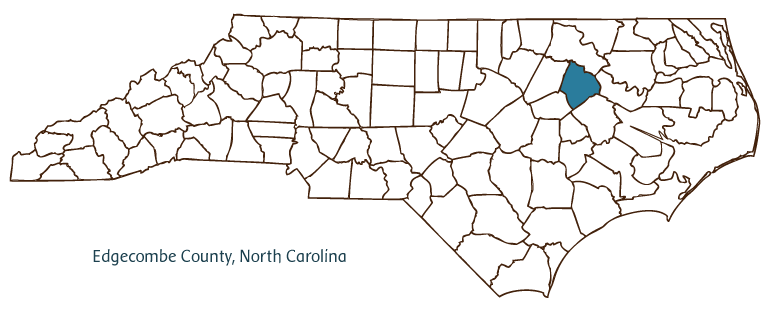Edgecombe County Resources
- View All:
- Biographies
- Monuments
- locations
Copyright Notice: This article is from the Encyclopedia of North Carolina edited by William S. Powell. Copyright © 2006 by the University of North Carolina Press. Used by permission of the publisher. For personal use and not for further distribution. Please submit permission requests for other use directly to the publisher.

Edgecombe County, located in the Coastal Plain region of eastern North Carolina, was formed in 1741 from Bertie County. It was named for Baron Richard Edgecombe, English member of Parliament and lord of the treasury. Aside from minor boundary adjustments, the county's present dimensions are the result of geographical divisions in 1746, 1758, 1777, and 1855 to form parts of Granville, Halifax, Nash, and Wilson Counties, respectively. In 1764 the county seat was moved from Edgecombe Court House to Tarboro. Other Edgecombe County communities include Conetoe, Leggett, Macclesfield, Pinetops, Princeville, Sharpsburg, Speed, Whitakers, and parts of Rocky Mount (which straddles the Edgecombe-Nash county border).
Tuscarora Indians originally inhabited the lands of Edgecombe County, and the English settlers who followed represented some of the first families of colonial North Carolina. The town of Princeville is also notable among Edgecombe County "firsts": established in 1865 by formerly enslaved people, it was the first all-black incorporated town in North Carolina. It and other Edgecombe County communities were devastated by the flooding of the Tar River following Hurricane Floyd in 1999. The first New Deal-era electrical cooperative began generating in Tarboro in 1937. The Tarboro Town Commons is today the only known example of a colonial common remaining in North Carolina.
Edgecombe County natural and cultural attractions include Riverfront Park in Tarboro and Battle Park in Rocky Mount; the Tar River Reservoir; Coolmore, an antebellum mansion built ca. 1860; and the Rocky Mount Arts Center. The Down East Festival of the Arts is held each October in Rocky Mount. Edgecombe County farms produce tobacco, cotton, corn, wheat, chickens, beef and dairy cattle, and peanuts, among other goods. County industrial products include furniture, farm machinery, electric transformers, and fabrics. In 2004 Edgecombe County's population was estimated to be 54,000.
For an annotated history of the county's formation, with the laws affecting the county, boundary lines and changes, and other origin information, visit these references in The Formation of the North Carolina Counties (Corbitt, 2000), available online at North Carolina Digital Collections (note, there may be additional items of interest for the county not listed here):
County formation history: https://digital.ncdcr.gov/Documents/Detail/the-formation-of-the-north-ca...
Index entry for the county: https://digital.ncdcr.gov/Documents/Detail/the-formation-of-the-north-ca...
References:
Sarah Veith Jenkins, The Edgecombe Story (1976).
Additional resources:
Corbitt, David Leroy. 2000. The formation of the North Carolina counties, 1663-1943. https://digital.ncdcr.gov/Documents/Detail/the-formation-of-the-north-carolina-counties-1663-1943/3692099?item=4553233 (accessed June 20, 2017).
Edgecombe County Government: https://www.edgecombecountync.gov/
DigitalNC, Edgecombe County: https://www.digitalnc.org/counties/edgecombe-county/
North Carolina Digital Collections (explore by place, time period, format): https://digital.ncdcr.gov
Image credits:
Rudersdorf, Amy. 2010. "NC County Maps." Government & Heritage Library, State Library of North Carolina.
Criner, Allyson C. "Edgecombe County." NCpedia. State Library of NC. November 2022. https://www.ncpedia.org/geography/edgecombe.
EDGECOMBE COUNTY GOVERNMENT:
https://www.edgecombecountync.gov/
COUNTY SEAT: Tarboro
FORMED: 1741
FORMED FROM: Bertie
LAND AREA: 505.34 square miles
2020 POPULATION ESTIMATE: 48,900
White: 39.7%
Black/African American: 57.8%
American Indian: 0.8%
Asian: 0.3%
Pacific Islander: 0.1%
Two or more races: 1.3%
Hispanic/Latino: 5.0% (of any race)
From State & County QuickFacts, US Census Bureau, 2020.
CONGRESSIONAL DISTRICT: 1ST
BIOGRAPHIES FOR![]()
Edgecombe County
 WILDLIFE PROFILES FOR
WILDLIFE PROFILES FOR
Coastal Plain
GEOGRAPHIC INFORMATION
REGION: Coastal Plain
RIVER BASIN: Tar-Pamlico, Map
NEIGHBORING COUNTIES: Halifax, Martin, Nash, Pitt, Wilson